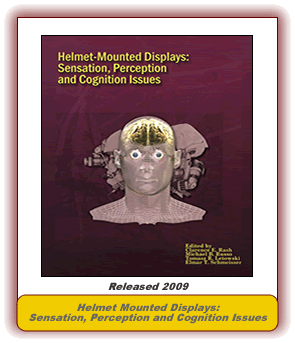Helmet-Mounted Displays Books

In 1999, the U.S. Army Aeromedical Research Laboratory (USAARL), Fort Rucker, Alabama, published a book that addresses issues for the design of helmet-mounted displays (HMDs) for use in helicopters, Helmet-Mounted Displays: Design Issues for Rotary-Wing Aircraft (USAARL, 1999). While primarily an engineering overview of image sources, image quality, optical design approaches, communication systems, hearing protection, and helmet head-supported mass and center-of-mass, the book also addresses such human factors issues as visual and auditory performance, head and face anthropometry, and hearing and vision protection.
In the years since the 1999 book was conceived, HMD applications have greatly expanded, not only within the military but also within the manufacturing and simulation training communities. Significant progress has been made in the development of image source technologies, especially miniature displays. This continuing image source development, coupled with advances in power source engineering - smaller size and greater efficiency, has greatly expanded the number of HMD applications. Within the U.S. Army, HMDs are being designed for use by dismounted and mounted Warfighters as well as for aviators.
As advanced technology penetrates the battlespace, the modern Warfighter is being provided with an ever-increasing stream of information. The motivation of this growing flow of information is the Army's objective to See First, Understand First, Act First, & Finish Decisively. Whether it is a field commander or a lower echelon soldier, every Warfighter will have greater access to both tactical and strategic data and imagery. The vast majority of this information will be presented to the Warfighter in visual and auditory forms via HMDs. For this reason, the design and implementation of HMDs must be optimized to ensure optimal user performance, both visual and auditory.
Paramount in achieving this optimization is attaining a thorough understanding of the relationship between HMDs and the human concepts of perception and cognition. An excellent beginning to acquiring this understanding can be found in Tactical Display for Soldiers-Human Factors Considerations (National Academy Press, 1997). Presenting the results of the Panel on Human Factors in the Design of Tactical Displays for the Individual Soldier (established by the National Research Council at the request of the U.S. Army Natick Research, Development, and Engineering Center, Natick, Massachusetts), this book discusses critical human factors issues associated with the development of the Army's proposed Land Warrior System, an individual Warfighter monocular HMD. The overall goal of the panel was to identify critical characteristics of HMDs and the capabilities and limitations of the target user (i.e., the Warfighter). One major finding of the panel was the presence of a lack of understanding of the impact of advanced HMD visual and auditory presentations on Warfighter workload, situational awareness and overall performance. This finding is well-known within the HMD community of researchers and often has been expressed as an important issue.
The work presented here is the second in a series of HMD books. Where the first book focused on engineering design issues, this book focuses on filling the National Research Councils identified gap in understanding the relationship between the HMD hardware design and user perception and cognition of the visual and auditory displays.
Continue reading by selecting an option below...

You can skip to any chapter/section within the book by selecting its corresponding entry below. All items below will open in PDF format. The PDF format requires that you have at least Adobe Reader 8 installed, or any other application capable of reading Adobe PDF files. Adobe Reader is free and available from Adobe's website @ www.adobe.com.
Left-clicking any of the below links will open a copy of that file in your browser via Adobe Reader. If you would like to download a section/chapter, simply right-click the entry and select the "save as" feature in the right-click menu to save a copy to your local hard drive or elsewhere.
Helmet Mounted Displays- Sensation, Perception and Cognitive Issues
Section 1 - Front Matter & Contributors (513KB) 
Section 2 - Table of Contents (510KB) 
Section 3 - Foreword (465KB) 
Section 4 - Preface (shown above) (535KB) 
Part I
Section 5 - Title & Part 1 (467KB) 
Section 6 - Chapter I/ The Military Operational Environment (2.05MB) 
Section 7 - Chapter II/ Human Machine Interface Challenge (2.26MB) 
Part II
Section 8 - Part Two (441KB) 
Section 9 - Chapter III/ Introduction to Helmet-Mounted Displays (5.74MB) 
Section 10 - Chapter IV/ Visual Helmet Mounted Displays (8.49MB) 
Section 11 - Chapter V/ Audio Helmet Mounted Displays (7.29MB) 
Part III
Section 12 - Part Three (441KB) 
Section 13 - Chapter VI/ Anatomy and Structure of the Eye (1.5MB) 
Section 14 - Chapter VII/ Visual Function (1.58MB) 
Section 15 - Chapter VIII/ Ear Anatomy (1.65MB) 
Section 16 - Chapter IX/ Auditory Function (1.04MB) 
Part IV
Section 17 - Part Four (441KB) 
Section 18 - Chapter X/ Visual Perception and Cognitive Performance (3.80MB) 
Section 19 - Chapter XI/ Auditory Perception and Cognitive Performance (3.37MB) 
Section 20 - Chapter XII/ Visual Perceptual Conflicts and Illusions (8.08MB) 
Section 21 - Chapter XIII/ Auditory Conflicts and Illusions (1.60MB) 
Section 22 - Chapter XIV/ Auditory-Visual Interactions (687KB) 
Section 23 - Chapter XV/ Cognitive Factors (4.36MB) 
Section 24 - Chapter XVI/ Perceptual and Cognitive Effects Due to Operational Factors (2.94MB) 
Part V
Section 25 - Part Five (442KB) 
Section 26 - Chapter XVII/ Guidelines for HMD Design (1.61MB) 
Section 27 - Chapter XVIII/ Exploring the Tactile Modality for HMDs (2.61MB) 
Section 28 - Chapter XIX/ The Potential of Interactive HMD (1.29MB) 
Closing Sections
Section 29 - Abbreviations (515KB) 
Section 30 - Glossary (704KB) 
Section 31 - Index (545KB) 
The views, opinions, and/or findings contained within the above sections/chapters and the "Helmet Mounted Displays- Sensation, Perception and Cognitive Issues" book as a whole are those of the authors and should not be construed as an official Department of the Army position, policy, or decision unless so designated by other official documentation.
back to top
Last Modified Date: 2024-11-27